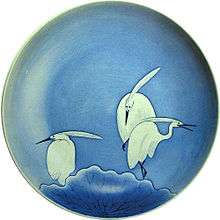
Incipient Jomon rope pottery 10000-8000 BCE

Middle Jomon Period rope pottery 5000-4000 BCE

Jomon vessel 3000-2000 BCE
The Jōmon Pottery (縄文式土器, Jōmon-shiki Doki) is a type of ancient pottery which was made during the Jōmon period in Japan. The term "Jōmon" (縄文) means "rope-patterned" in Japanese, describing the patterns that are pressed into the clay.
Outline
Oldest Pottery in Japan
The pottery vessels crafted in Ancient Japan during the Jōmon period are generally accepted to be the oldest pottery in Japan.
Dating
Bits of pottery discovered in a cave in the northwest coast of modern-day Kyushu date back to as far as 12,700 BCE in radiometric dating tests.[1] It is believed by many that Jōmon pottery was probably made even earlier than this date. However, due to ambiguity and multiple sources claiming different dates based on different dating techniques, it is difficult to say for sure how far back Jōmon Pottery was made. Some sources claim archaeological discoveries as far back as the 14th millennium BCE.[2]
Jōmon Chronology
The Jōmon Period in Ancient Japan lasted until roughly 300 BCE. From there, it is divided into six periods: Incipient Jōmon, from 10,500-8,000 BCE, Earliest Jōmon, from 8,000-5,000 BCE, Early Jōmon, from 5,000-2,500 BCE, Middle Jōmon, from 2,500- 1,500 BCE, Late Jōmon, from 1,500-1,000 BCE, and Final Jōmon, from 1,000-300 BCE.[3] There are over 80 sites in Japan where Incipient Jōmon pottery vessels have been found,[2] but the majority of Jōmon pottery remains come from the later periods.
Characteristics
The majority of Jōmon pottery has rounded bottoms and the vessels are typically small. This shows that the vessels would typically be used to boil food, perhaps fitting into a fire.[4] Later Jōmon pottery pieces are more elaborate, especially during the Middle Jōmon period, where the rims of pots became much more complex and decorated.[1]
The name Jōmon itself means “rope-patterned”. This refers to the impressions on the surface of the pottery which were created by pressing rope into the clay before it was heated to approximately 600-900 degrees Celsius.[1]
See also
References
- 1 2 3 Rice, Prudence M. “On the Origins of Pottery.” Journal of Archaeological Method and Theory 6, no. 1 (1999): 1-54. Database on-line. Springerlink; accessed October 3, 2007.
- 1 2 Kuzmin, Yaroslav V. “Chronology of the earliest pottery in East Asia: progress and pitfalls.” Antiquity 80, (2006): 362-371. Database on-line. EBSCOhost; accessed October 3, 2007.
- ↑ Hall, M. E. “Pottery Styles during the Early Jomon Period: Geochemical Perspectives on the Moroiso and Ukishima Pottery Styles.” Archaeometry 43, no. 1 (2001): 59-75. Database on-line. Academic Search Complete, EBSCOhost; accessed October 5, 2007.
- ↑ Pearson, Richard. “Debating Jomon Social Complexity.” Asian Perspectives 46, no.2 (2007): 361-388. Database on-line. Project Muse; accessed October 5, 2007.
External links
|
|---|
| | | | | | |
|---|
| | Ceremonial | |
|---|
| | Dwellings | |
|---|
| | Water management | |
|---|
| | Other architecture | |
|---|
|
| | |
|



